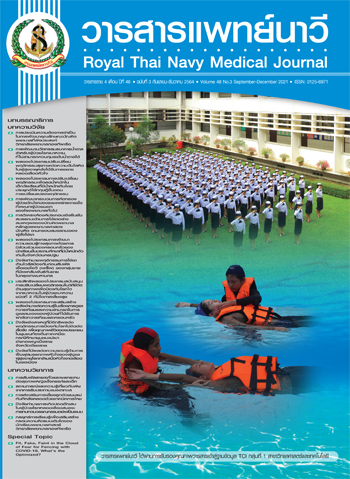ผลของโปรแกรมการปรับเปลี่ยนพฤติกรรมเพื่อลดน้ำหนักในเด็กวัยเรียนที่มีน้ำหนักเกินโดยประยุกต์ใช้ทฤษฎีขั้นตอนการเปลี่ยนแปลงพฤติกรรม
Main Article Content
บทคัดย่อ
การศึกษาครั้งนี้เป็นการวิจัยกึ่งทดลองแบบสองกลุ่มวัดผลก่อน-หลัง เพื่อศึกษาผลของโปรแกรมการปรับเปลี่ยนพฤติกรรมเพื่อลดน้ำหนักในเด็กวัยเรียนที่มีน้ำหนักเกินโดยประยุกต์ใช้ทฤษฎีขั้นตอนการเปลี่ยนแปลงพฤติกรรม กลุ่มตัวอย่าง คือ เด็กวัยเรียนที่มีน้ำหนักเกินเกณฑ์ในระดับ + 2 SD ถึง + 3 SD กำลังศึกษาอยู่ระดับชั้นประถมศึกษาปีที่ 4 - 6 ในโรงเรียนพื้นที่เขตสวนหลวง สังกัดกรุงเทพมหานคร กลุ่มตัวอย่างโดยใช้การสุ่มโรงเรียนในพื้นที่จำนวน 54 คน จัดเข้าสู่กลุ่มทดลองและกลุ่มควบคุมกลุ่มละ 27 คน สุ่มตัวอย่างแบบง่าย เครื่องมือในการดำเนินการวิจัย คือ โปรแกรมการปรับเปลี่ยนพฤติกรรมเพื่อลดน้ำหนักในเด็กวัยเรียนที่มีน้ำหนักเกินโดยประยุกต์ใช้ทฤษฎีขั้นตอนการเปลี่ยนแปลงพฤติกรรม เครื่องมือในการเก็บรวบรวมข้อมูล คือ แบบสอบถามพฤติกรรมการออกกำลังกายและพฤติกรรมการบริโภคอาหาร ผ่านการประเมินคุณภาพความตรงตามเนื้อหาโดยผู้ทรงคุณวุฒิ 3 ท่าน มีค่าความตรงเท่ากับ 0.90 ค่าความเที่ยงของแบบสอบถามด้านพฤติกรรมการออกกำลังกาย เท่ากับ 0.83 และแบบสอบถามด้านพฤติกรรมการบริโภคอาหาร เท่ากับ 0.70 การเก็บข้อมูลก่อนและหลังการทดลองด้วยแบบสอบถามข้อมูลส่วนบุคคล แบบประเมินขั้นตอนการเปลี่ยนแปลงพฤติกรรม แบบสอบถามพฤติกรรมการออกกำลังกายและพฤติกรรมการบริโภคอาหาร วิเคราะห์ข้อมูลด้วยสถิติพรรณนา และสถิติทดสอบค่าที
ผลการศึกษาหลังการทดลอง พบว่า ค่าเฉลี่ยพฤติกรรมการออกกำลังกายของกลุ่มทดลองสูงกว่าก่อนการทดลอง (M = 9.67, SD = 2.70) หลังการทดลอง (M = 17.37, SD = 3.10)อย่างมีนัยสำคัญ (t = -11.87, p < .01) และสูงกว่ากลุ่มควบคุม (M = 10.85, SD = 2.48) อย่างมีนัยสำคัญ (t = -8.53, p < .01) ค่าเฉลี่ยพฤติกรรมการบริโภคอาหารของกลุ่มทดลองสูงกว่าก่อนการทดลอง (M = 11.44, SD = 1.42) หลังการทดลอง (M = 18.74, SD = 2.30) อย่างมีนัยสำคัญ (t = -12.54, p < .01) และสูงกว่ากลุ่มควบคุม (M = 12.93, SD = 1.86) อย่างมีนัยสำคัญ (t = -10.23, p < .01) ค่าเฉลี่ยน้ำหนักตัวของกลุ่มทดลองต่ำกว่าก่อนการทดลอง (M = 61.44 กิโลกรัม, SD = 11.04) หลังการทดลอง (M = 58.70, SD = 11.16) อย่างมีนัยสำคัญ (t = 14.18, p > 0.01) และต่ำกว่ากลุ่มควมคุม (M = 64.47, SD = 9.54) อย่างมีนัยสำคัญ (t = 2.04, p < .05) ค่าเฉลี่ยเปอร์เซ็นต์ไขมันสะสมในร่างกายของกลุ่มทดลองต่ำกว่าก่อนการทดลอง(M = 35.50%, SD = 2.90) หลังการทดลอง (M = 33.80%, SD = 3.02) อย่างมีนัยสำคัญ (t = 11.23, p < .01) และต่ำกว่ากลุ่มควบคุม (M = 36.70%, SD = 2.51) อย่างมีนัยสำคัญ (t = 3.84, p < .01)
จากผลการศึกษานี้แสดงให้เห็นว่า โปรแกรมการปรับเปลี่ยนพฤติกรรมเพื่อลดน้ำหนักในเด็กวัยเรียนที่มีน้ำหนักเกินโดยประยุกต์ใช้ทฤษฎีขั้นตอนการเปลี่ยนแปลงพฤติกรรม มีผลต่อการปรับเปลี่ยนพฤติกรรมและสามารถลดน้ำหนักตัวและไขมันสะสมในเด็กวัยเรียนได้ จึงขอเสนอแนะว่าควรนำโปรแกรมนี้ไปใช้เป็นแนวทางในการป้องกันและควบคุมน้ำหนักในเด็กวัยเรียนที่มีน้ำหนักเกินเกณฑ์ต่อไป
Article Details

This work is licensed under a Creative Commons Attribution-NonCommercial-NoDerivatives 4.0 International License.
References
Bureau of Nutrition, Department of Health. Guideline for controlling and prevention obesity in school age. Nonthaburi: Ministry of Public Health; 2017. (in Thai)
Department of Health. Information system to support the promotion of health and environmental health. [Internet]. 2021. [cited 2021 April 10]. Available from: http://dashboard.anamai.moph.go.th/dashboard/overweightstudent/index?year=2019.
Cholphon A. The characteristics regarding nutritional status of overnutrition students in the schools of Lamphun Municipal Area. [Master’s Thesis, Faculty of Public Health]. Chaing Mai University; 2008. (in Thai).
Sirikulchayanonta C. Obesity in school-age children from molecules to communities. Bangkok: Best Graphic; 2011. (in Thai).
Bureau of Nutrition, Department of Health. Guideline for controlling and prevention obesity in school age. Nonthaburi: Ministry of Public Health; 2017. (in Thai).
Health Promotion Division. Plans and results of measures to prevent obesity and malnutrition in schools. Bangkok: The Bangkok Metropolitan Administration (BMA) Health Department; 2558. (in Thai).
Aussaree P, Rasiri T, Branom R. Effect of health alliance nursing program on food consumption and exercise behaviors in obese school age children. Journal of Boromarajonani College of Nursing, Bangkok 2013;29(1):121–34. (in Thai).
Choojan S, Thongbai W, Kummabut J. The effects of self-efficacy and family support promotion program on consumption behavior among late school aged children with overweight. Journal of Boromarajonani College of Nursing, Bangkok 2016;31(1):31-43. (in Thai).
Keawtach V. Effects of dietary and physical activity behaviors promotion program for overweight students in Bangkok Metropolitan School. [Master’s Thesis, Faculty of Public Health]. Mahidol University; 2013. (in Thai).
Jantacumma N, Manachevakul S, Cheevakasemsook A, Kaewsan P, Sanboonsong P. Effects of a school-based overweight control program on primary school students in Nonthaburi province. Royal Thai Navy Medical Journal 2020;47(2):301-16. (in Thai).
Samart S, Sota C. The effectiveness of health education program applying self-efficacy and stages of change for weight reduction among working age 40-49 years old group with overweight and obesity in Nongkungshern subdistrict, Phu Wiang district, Khon Kaen province. The Office of Disease Prevention and Control 7 Khon Kaen 2016;23(3):34-45. (in Thai).
Watcharasin J, Rattanamanee K, Chewanon N. The development of physical activity and eating behavior changing model for overweight school-age children and adolescents, East Coast Thailand (Phase I). [Internet]. [cited 2019 September 9]. Available from: http://dspace.lib.buu.ac.th/xmlui/bitstream/handle/12345678903549/2562_094. (in Thai).
Kamolsoponvasin S. A behavioral study of Generation Z adolescence towards Buddhist media in Bangkok. [Dissertation]. Thammasat University; 2013. (in Thai).
Prochaska JO, Diclemente CC. Stages and processes of self-change of smoking: toward an integrative model of change. Journal of Consulting and Clinical Psychology 1983;56(4):520-8.
Gao Z, Chen S, Pasco D, Pope Z. A meta-analysis of active video games on health outcomes among children and adolescents: obesity reviews. An Official Journal of The International Association for the Study of Obesity 2015;16(9):783-94.
Faul F, Erdfelder E, Lang A, Buchner A. G*Power 3: a flexible statistical power analysis for the social behavioral and biomedical sciences. Behavior Research Methods 2007;39(2):175-91.
Panitkul K, Sumranbua A. An application of transtheoretical model to promote exercise. The Journal of Boromarajonani College of Nursing Nakhonratchasima 2013;19(1):66-78. (in Thai).
Marcus BH, Owen N. Motivation readiness self-efficacy and decision-making for exercise. Journal of Applied Social Psychology 1992;22(1):3-16. Doi: 10.1111/j.1559-1816.1992.tb01518.x.
Prochaska JO, Velicer WF. The transtheoretical model of health behavior change. American Journal of Health Promotion 1997;12(1):38-48. doi: 10.4278/0890-1171-12.1.38.
Heather M, Valerie C, Paul C, Robert T. Childhood obesity: a transtheoretical case management approach. J. Pediatr Nurs 2008;23(5):337-44.
Tuah N, Amiel C, Qureshi S, Car J, Kaur B, Majeed A. Transtheoretical model for dietary and physical exercise modification in weight loss management for overweight and obes adults. Cochrane Database of Systematic Rev. [Internet]. [cited 2016 November 10]. Available from: https://www.ncbi.nlm.nih.gov/pubmed/21975777#
Nudla P, Jittanoon P, Balthip K. Impact of an internet-mediated over-consumption self reminding programme on the body weight and consumption behaviour of overnutrition adolescents. Thai Journal of Nursing Council 2017;32(1):32-46. (in Thai).
Ham OK, Sung KM, Lee BG, Choi HW, Im Ek. Transtheoretical model-based exercise counseling combined with music skipping rope exercise on childhood obesity. Asian Nursing Research 2016;10(2):116-22.

